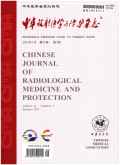基于光学体表监测的左侧乳腺癌深吸气屏气放疗实时三维在体剂量验证分析
Optical surface monitoring-based real-time 3D in vivo dose verification for patients with left breast cancer undergoing deep inspiration breath-hold radiotherapy
摘要目的:对光学体表监测下的左侧乳腺癌深吸气屏气门控放疗(DIBH-SGRT)患者进行三维在体剂量验证,研究靶区剂量学差异以及影响通过率指标的相关因素。方法:选取浙江大学医学院附属妇产科医院放疗科行DIBH-SGRT的20例左侧乳腺癌患者,记录光学体表监测下患者DIBH过程中的分次内位移偏差,同时所有患者在治疗过程中均进行基于电子射野影像装置的三维在体剂量(EIVD)验证,统计2 mm/2%、3 mm/3%与3 mm/5%的3类γ通过率。以剂量体积直方图(DVH)参数,评估肿瘤靶区与危及器官的剂量学差异。采用Pearson相关性分析,计算3类γ通过率与剂量学差异、位移偏差间的相关性。结果:2 mm/2%、3 mm/3%和3 mm/5%的平均γ通过率分别为73.43%、86.00%和92.96%,EIVD测量剂量与计划剂量在计划瘤床靶区体积(PTV_TB)和计划靶区体积(PTV) Dmean的平均剂量偏差为0.23%和0.59%( P>0.05)。Pearson分析显示,γ通过率与肿瘤靶区的剂量学差异相关性较弱( R<0.7),与分次内DIBH的左右(Lat)方向和升降(Vert)方向位移偏差相关性较强( R>0.7)。 结论:三维EIVD验证能够有效保证左侧乳腺癌DIBH-SGRT过程中肿瘤靶区剂量传递的精准性,同时EIVD系统能够潜在发现患者屏气过程中的位移偏差。
更多相关知识
abstractsObjective:To perform optical surface monitoring-based three-dimensional (3D) in vivo dose verification for patients with left breast cancer undergoing deep inspiration breath-hold surface-guided radiation therapy (DIBH-SGRT) and to investigate the dosimetric differences in the target volumes and related factors affecting γ pass rates. Methods:Totally 20 patients with left breast cancer who received DIBH-SGRT at the Department of Radiation Oncology, Women′s Hospital, School of Medicine, Zhejiang University were selected. The optical surface monitoring-based intrafractional displacement deviations of the patients during DIBH were recorded. Meanwhile, electronic portal imaging device (EPID)-based in vivo dosimetry (EIVD) verification was performed for patients during the DIBH-SGRT, and γ pass rates were measured with the criteria of 2 mm/2%, 3 mm/3%, and 3 mm/5%. The dosimetric differences between planning target volumes (PTVs) and organs at risk (OARs) were analyzed based on dose-volume histograms (DVHs). Furthermore, Pearson correlation analysis was employed to determine the correlation of three γ pass rates with dosimetric differences and displacement deviations. Results:The average pass rates with the criteria of 2 mm/2%, 3 mm/3%, and 3 mm/5% were determined at 73.43%, 86.00%, and 92.96%, respectively, and the average deviations between EIVD measured doses and planned doses in PTV_TB and PTV Dmean were proved to be 0.23% and 0.59%, respectively ( P > 0.05). Pearson analysis revealed that the γ pass rates exhibited a weak correlation with dosimetric differences in PTVs( R<0.7) but strong correlations with intrafractional displacement deviations in Lat and Vert directions during DIBH ( R > 0.7). Conclusions:EIVD verification can ensure the high accuracy of dose delivery in PTVs during DIBH-SGRT for left breast cancer. Additionally, the EIVD verification system has the potential to detect displacement deviations during breath holding.
More相关知识
- 浏览0
- 被引0
- 下载0


相似文献
- 中文期刊
- 外文期刊
- 学位论文
- 会议论文



 换一批
换一批 换一批
换一批



